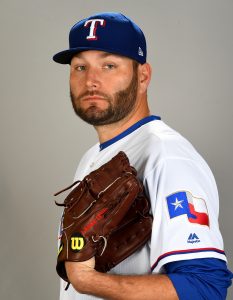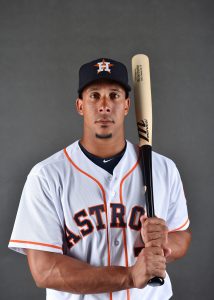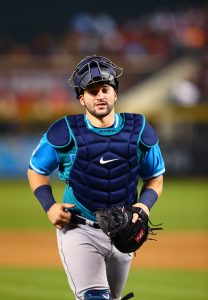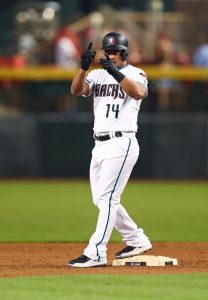This is the latest post of MLBTR’s annual Offseason in Review series, in which we take stock of every team’s winter dealings.
The fruits of a relatively short rebuilding effort in Milwaukee manifested with an NL Central division title, a NLCS run against the Dodgers and dramatic increase in expectations after years of mediocrity.
Major League Signings
- Yasmani Grandal, C: One year, $18.25MM (includes $2MM buyout on 2020 mutual option)
- Mike Moustakas, 2B/3B: One year, $10MM
- Cory Spangenberg, 2B/3B/OF: One year, $1.2MM (split Major League contract)
- Jake Petricka, RHP: $900K (split Major League contract)
- Total spend: $30.35MM
Trades and Claims
- Acquired RHPs Bobby Wahl, RHP Adam Hill and 2B Felix Valerio from the Mets in exchange for OF Keon Broxton
- Acquired LHP Alex Claudio from the Rangers in exchange for Competitive Balance Round A draft pick
- Acquired OF Ben Gamel, RHP Noah Zavolas from Mariners in exchange for OF Domingo Santana
Notable Minor League Signings
Notable Losses
- Gio Gonzalez, Wade Miley, Joakim Soria, Curtis Granderson, Jonathan Schoop, Jordan Lyles, Xavier Cedeno, Dan Jennings
[Milwaukee Brewers depth chart | Milwaukee Brewers payroll outlook]
Needs Addressed
Entering the offseason with a pair of catchers who combined to hit .246/.296/.379, the Brewers had a clear need behind the plate. While Manny Pina and Erik Kratz gave the Brewers quality defense behind the dish in terms of framing and controlling the running game, their lack of offense was a clear negative. Brewers president of baseball operations David Stearns and his staff clearly agreed, and while they didn’t feel strongly enough to make a significant play for a free agent on a multi-year contract, they deftly swooped in and secured Yasmani Grandal, the open market’s top catcher, on a one-year deal worth $18.25MM after Grandal apparently didn’t find any multi-year offers that were to his liking (despite numerous reports indicating that he received substantial multi-year offers from the likes of the Mets, Twins and White Sox).
Maybe Grandal was stung a bit by recency bias — his postseason showing was nightmarish on both sides of the ball — but the 30-year-old finished second among MLB catchers in total home runs and led all MLB backstops (min. 300 PAs) with a hefty .225 ISO (slugging minus batting average). Salvador Perez is the only catcher with more home runs than Grandal over the past four seasons, and among qualified backstops, only Gary Sanchez and Robinson Chirinos have higher ISO marks. That the Brewers were able to add one of baseball’s most powerful catchers — one who consistently rates as a premium framer with a solid caught-stealing rate — on a one-year pact is a feather in an already plumage-laden cap for the front office.
Entering the 2018 season, much was made of Milwaukee’s glut of outfielders, and that relative logjam came into greater focus this winter with both Domingo Santana and Keon Broxton out of options and clearly lacking a path to playing time with the Brewers. Broxton and Santana were turned into a potential bullpen piece — Bobby Wahl, though he’s since unfortunately suffered an ACL tear — and another interesting outfielder with a minor league option remaining: Ben Gamel. Stearns & Co. further bolstered the ’pen by swapping their Competitive Balance draft pick for lefty Alex Claudio. Unlike many other trades in which teams have shipped off those rare, tradeable picks for marginal assets or even pure salary relief, the Brewers landed a useful left-handed arm who’ll make their club better in 2019 and beyond, as Claudio can be controlled through 2021.
In need of infield help after spending an otherwise successful season jamming square pegs into second-base, third-base and shortstop-shaped holes, the Brewers did sign a pair of infielders in the form of a returning Mike Moustakas and former Padre Cory Spangenberg. The return of “Moose” will at the very least bolster an already formidable Milwaukee lineup by adding a bat that’s swatted 66 long balls over the past 300 games.
Questions Remaining
The Moustakas addition seems like an apt place to transition from the “needs addressed” to the “questions remaining” section, given that it’s anyone’s guess as to how Moustakas will adjust to his new role as a second baseman. He’s never played the position in the past but is getting his feet wet this spring in preparation for serving as Milwaukee’s everyday option at the position. It’s an unorthodox move but one that is backed by at least some logic. Milwaukee is typically aggressive in its infield shifting. Moustakas has played on the right side of the infield in the past when shifting there against left-handed hitters as a third baseman. The position may not ultimately feel *that* foreign to him.
Some may argue that the Brewers swooped in on Moustakas in a similar manner to the way they did Grandal. But Grandal was a more unique asset, whereas the Brewers paid a fairly sizable (but still reasonable) sum to once again play a veteran infielder out of position. For the same $10MM they promised to Moustakas, the Brewers could’ve signed Brian Dozier or brought Jonathan Schoop back aboard to play his natural position. Even if the Brewers weren’t keen on a bounceback candidate at the position, Moustakas’ $10MM guarantee is the same as Jed Lowrie’s annual rate on his two-year pact with the Mets. It’s only slightly shy of the $12MM annual value on DJ LeMahieu’s two-year deal with the Yankees. Even at his more natural third base, Moustakas would only be projected to be worth two or two-and-a-half wins above replacement. For this price, it seems like the Brewers could’ve gotten a natural second baseman without incurring much long-term risk.
For the second straight spring, however, the largest question many have regarding Milwaukee is whether the team should have added more starting pitching. Jhoulys Chacin, last winter’s lone big league signing, is slated to take the ball on Opening Day. But the Brewers didn’t add a starter this winter after bidding adieu to both Wade Miley and Gio Gonzalez, instead banking on the return of a healthy Jimmy Nelson and doubling down in their faith in young righties Corbin Burnes, Brandon Woodruff and Freddy Peralta — each of whom tallied significant innings in the Majors last season. That group, paired with holdovers Chase Anderson, Zach Davies and Junior Guerra, will be tasked with rounding out the starting staff and at least getting the Brewers to the trade deadline.
It’s a lot to ask from a unit full of pitchers that either have lacked consistency (Anderson, Davies, Guerra) or lack MLB starting experience (Burnes, Woodruff, Peralta), but the group undeniably features plenty of talent. A healthy Nelson in 2017 was one of the National League’s most valuable starting pitchers. Burnes and Woodruff were well-regarded as prospects and both impressed in bullpen roles last season, with Burnes in particular showing off-the-charts spin on his fastball and curveball. Peralta was serviceable in 14 starts last season with secondary stats that were more impressive than his pedestrian 4.25 ERA.
It’s technically possible that the Brewers could make one final late-offseason splash, bringing in Dallas Keuchel or striking some kind of surprise trade, but the Brewers have continually showed faith in their internal arms by eschewing significant free-agent splashes over the past two offseasons. Owner Mark Attanasio would need to further push up an already club-record $128MM Opening Day payroll projection, and any new free-agent addition would need time to get up to speed and get into game-ready shape. Frankly, another addition doesn’t seem all that likely, but if Milwaukee’s starting staff is in tatters early in the year, there’ll be no shortage of people wondering why the reigning division champs opted to forgo a more stable addition.
Looking beyond the rotation, there’s even a bit of uncertainty within the team’s vaunted bullpen. Specifically, Jeremy Jeffress is battling a shoulder issue that has limited him substantially in Spring Training. Jeffress was a major part of getting the Brewers to the postseason in ’18, forming a dominant trio with Josh Hader and Corey Knebel. Those two should still be a powerful one-two punch late in games, but any relief corps is going to look a bit less imposing when you subtract a reliever who posted a 1.29 ERA in 76 2/3 regular-season innings.
2019 Season Outlook
Rotation questions aside, the Brewers will boast a formidable lineup with quality overall defense (particularly from Lorenzo Cain, Christian Yelich, Travis Shaw and Orlando Arcia) and a bullpen featuring two of the game’s top strikeout specialists. A return to health for Nelson and even one of the aforementioned young arms cementing himself as a viable mid-rotation starter would quiet a substantial portion of fan concern regarding the pitching staff, and if two members of that youth movement step up, the Brewers will look wise to have shown restraint.
A much-improved Reds roster, the Cardinals’ acquisition of Paul Goldschmidt and potential returns to health for Kris Bryant and Yu Darvish in Chicago should make the NL Central an even tougher division for all five clubs in 2019. But the Brewers could be getting a star of their own back (Nelson), and they’ll still head into the upcoming season not just with an eye on defending the division crown but with legitimate World Series aspirations. They’ll quite likely need another acquisition or two at baseball’s now-single trade deadline on July 31 — there won’t be another run of August acquisitions for Stearns & Co. — but I’ll be surprised if Milwaukee isn’t firmly in the postseason hunt once again this summer.
How would you grade the Brewers’ offseason? (link to poll for Trade Rumors app users)



 The Rays ended up doing in a different direction to address that latter need at catcher….well, as much as a Rays/Mariners trade can be described as “different” given the two clubs’ extensive history of deals. This time, the Rays and M’s combined on a five-player swap that saw Mallex Smith go to Seattle, while Tampa Bay added Guillermo Heredia to more or less take Smith’s place in the outfield, plus acquired catcher Mike Zunino to bring some stability behind the plate.
The Rays ended up doing in a different direction to address that latter need at catcher….well, as much as a Rays/Mariners trade can be described as “different” given the two clubs’ extensive history of deals. This time, the Rays and M’s combined on a five-player swap that saw Mallex Smith go to Seattle, while Tampa Bay added Guillermo Heredia to more or less take Smith’s place in the outfield, plus acquired catcher Mike Zunino to bring some stability behind the plate.